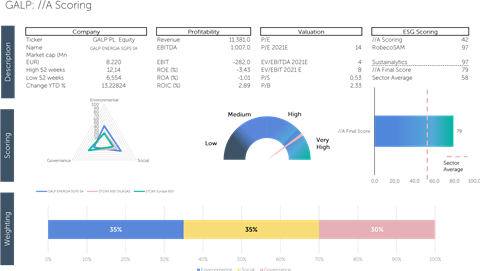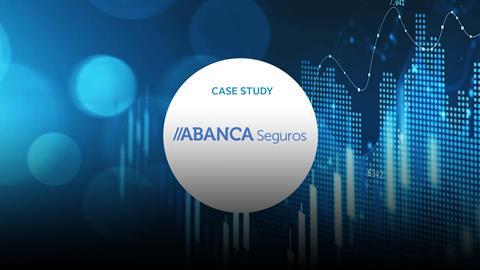- Signatory type: Asset owner
- HQ Country: Spain
ABANCA Vida y Pensiones’ investment analysis department has developed a scoring methodology for assessing potential investments for its life and non-life insurance company portfolios and its pension portfolios. The system is designed to identify best-in-class companies in each sector to achieve a balance between sustainability and profitability. The information used for the preparation of the score is taken from external providers of sustainability information and from data provided by the companies themselves.
ABANCA Vida y Pensiones decided to develop its own methodology due to the heterogeneity of criteria when determining the sustainability of a company from a mainly quantitative point of view. There was a need to create a system that is as objective as possible with tangible and measurable data allowing the internal team audit the scores provided by external providers. This methodology has become the fundamental axis of its investment process, called Alpha 360, in which asset management and investment analysis are separated to improve decision-making through independence in the generation of ideas and analysis of assets from both the financial and sustainability points of view.
Why this approach?
This methodology has two modules:
Quantitative module
This is the essence of the score developed by ABANCA Seguros. It has identified 94 quantitative variables, comprising 23 environmental indicators, 42 social indicators and 29 governance indicators. Twenty cover adherence of the analysed company to environmental and social policies, while the rest are quantifiable indicators relating to its environmental, social and governance behaviour.
In the environmental section, the variables are grouped into five categories: emissions; energy consumption; water consumption; waste production; and adherence to good environmental practice policies.
The social section has seven categories: employees; diversity; salary gap; training; safety; supply chain; and adherence to good practices in the social sphere. Finally, the good governance section includes seven categories: board structure; independence; diversity; meetings; analysis of the audit committee; analysis of the compensation committee; and analysis of the appointments committee.
Each of these indicators is analysed individually through a historical analysis comparing the latest annual figure with the average of the last five years. If the indicator is positive, the company receives a weighted score and, if negative, a zero score.
The weighting of the categories is carried out according to the materiality of risks in each sector, to adapt the score to the conditions of each company and its industry. This creates a dynamic score that helps ABANCA Seguros to (i) evaluate the efforts of companies to provide ESG data, (ii) identify the areas where companies have performed worse, and (iii) analyse both positive and negative trends.
Qualitative module
For the qualitative aspect, ABANCA Seguros relies on two external information providers – and applies a methodology which includes less tangible aspects related to ESG.
The final score of the methodology is a weighted average of the quantitative and qualitative assessments.

What were the outcomes, benefits, challenges and next steps?
ABANCA Seguros encountered two major challenges when building and using its scoring system. The first is scarcity of data, especially from small-cap companies, which often lack sufficient resources to provide quantitative ESG information. This explains the need for the firm to also rely on external providers. However, it believes that its tailored methodology places it ahead of regulation and will ensure it will therefore be prepared so that, as ESG data publishing becomes more consistent and mandatory, its system will generate better investment ideas and reduce dependency on providers.
The second challenge lies in finding a balance between sustainability and profitability. Best-in-class companies often trade at a premium.
The result of incorporating its own methodology into the employment plans managed by its insurance company has been, on the one hand, compliance with the requirements demanded by the regulator in terms of sustainability, where all portfolios surpass 70% of the total amount considered to be sustainable and, on the other hand, profitability achieved for participants. Here, according to Spanish newspaper El Economista, ABANCA’s employee pension plan was ranked the eighth most profitable of the 20 largest employment pension plans by equity volume in 2020, where only 55% of the total obtained positive returns.
The tool is designed to be aligned with the organisation’s overall investment strategy, ensuring that it is scalable, allowing the analysis not only of specific companies but also entire indices and baskets of stocks with thematic proposals. In addition, it can also be extended to other departments of the bank, such as the bank’s own-account department, should managers want to evaluate cash equity investments or ETFs. Moreover, the asset management department can use the tool to audit investment funds to incorporate them into the distribution lists for personal banking and private banking customers, as well as funds used in discretionary management portfolios, to ensure that the assets (equities, credit, ETFs) that make up the funds are sustainable.
This sustainability scoring system has become an integral part of the firm’s investment process. ABANCA Seguros will continue to expand its functionality to comply with regulatory requirements (such as alignment with the EU Taxonomy, which is the long-term corporate goal, and gradually adapting its processes and products, according to the supervisor’s sustainability criteria) and expand it to include impact variables related to the UN Sustainable Development Goals and to the recommendations of the Task Force on Climate-Related Financial Disclosures, which cover disclosures of climate-related impacts, to improve decision-making by managers.












